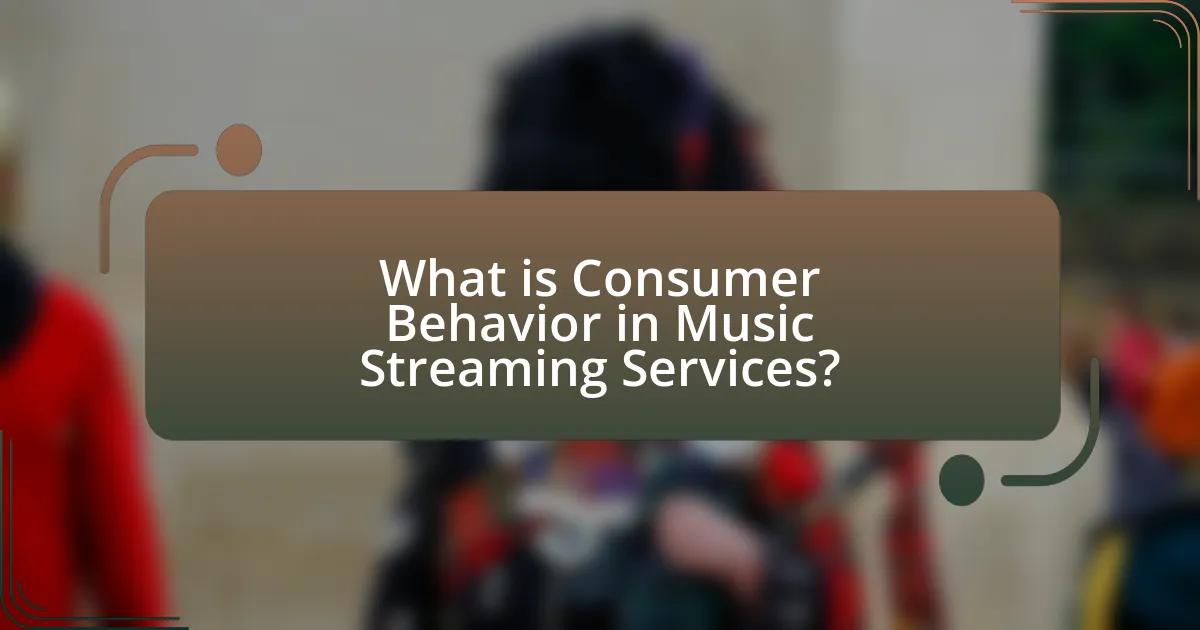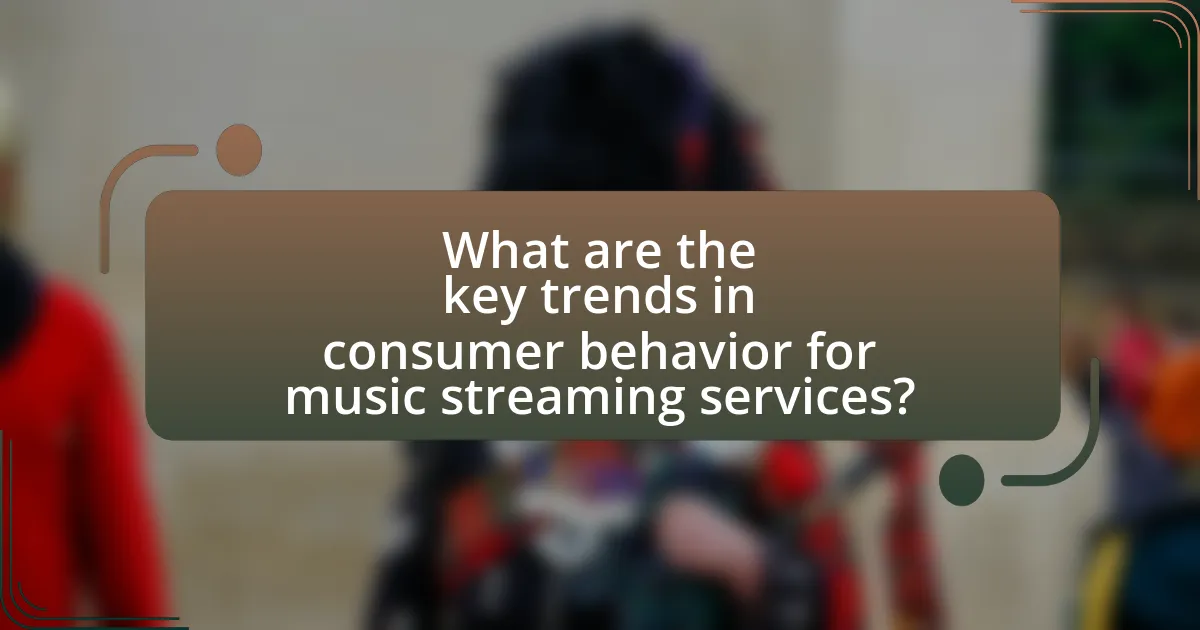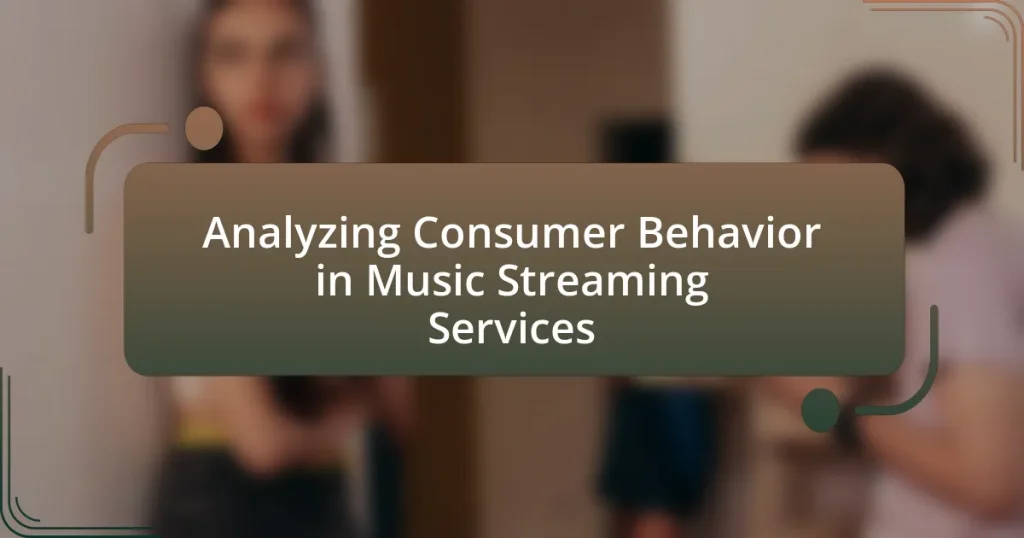The article focuses on analyzing consumer behavior in music streaming services, examining how users select, consume, and interact with music content on digital platforms. It highlights the influence of factors such as personalized recommendations, user interface design, and social sharing features on user engagement and satisfaction. Key trends, including the rise of mobile access and the impact of demographic factors on music preferences, are discussed, along with the importance of understanding consumer behavior for optimizing service design and marketing strategies. The article also addresses how streaming services utilize data analytics to enhance user experience and drive engagement through targeted marketing campaigns.

What is Consumer Behavior in Music Streaming Services?
Consumer behavior in music streaming services refers to the patterns and preferences exhibited by users when selecting, consuming, and interacting with music content on digital platforms. This behavior is influenced by factors such as user interface design, personalized recommendations, subscription models, and social sharing features. For instance, a study by the International Journal of Information Management found that 70% of users prefer platforms that offer personalized playlists, indicating that tailored experiences significantly impact user engagement and satisfaction. Additionally, the rise of mobile access has shifted consumer behavior towards on-demand listening, with 80% of users accessing music through mobile devices, highlighting the importance of convenience in user choices.
How do consumers interact with music streaming platforms?
Consumers interact with music streaming platforms primarily through content discovery, playlist creation, and social sharing. They utilize features such as personalized recommendations, search functions, and curated playlists to find new music that aligns with their preferences. According to a 2022 report by the International Federation of the Phonographic Industry, 72% of users rely on algorithm-driven recommendations to discover new artists and songs. Additionally, consumers often create and share their own playlists, fostering a sense of community and engagement within the platform. Social features, such as sharing music on social media or collaborating on playlists, further enhance user interaction, making the experience more interactive and personalized.
What factors influence user engagement on these platforms?
User engagement on music streaming platforms is influenced by content variety, personalization, user interface design, and social interaction features. Content variety ensures users have access to a wide range of music genres and artists, which keeps them interested and encourages longer listening sessions. Personalization, driven by algorithms that recommend songs based on listening history, enhances user satisfaction and retention; studies show that personalized playlists can increase user engagement by up to 30%. User interface design affects how easily users can navigate the platform, with intuitive designs leading to higher engagement rates. Lastly, social interaction features, such as sharing playlists and following friends, foster a sense of community, which can significantly boost user activity and loyalty on these platforms.
How do user preferences shape the content offered by streaming services?
User preferences significantly shape the content offered by streaming services through data-driven algorithms that analyze viewing habits and engagement metrics. Streaming platforms like Netflix and Spotify utilize user data, such as watch history, likes, and search queries, to tailor recommendations and curate playlists that align with individual tastes. For instance, a report by PwC indicates that 70% of viewers engage with content recommended to them, demonstrating the effectiveness of personalized content strategies. This targeted approach not only enhances user satisfaction but also drives higher retention rates, as users are more likely to continue subscriptions when they find content that resonates with their preferences.
Why is understanding consumer behavior important for music streaming services?
Understanding consumer behavior is crucial for music streaming services because it enables these platforms to tailor their offerings to meet user preferences and enhance user engagement. By analyzing listening habits, demographic data, and feedback, services can create personalized playlists, recommend new music, and optimize user interfaces. For instance, a study by Nielsen Music found that 70% of listeners prefer personalized recommendations, highlighting the importance of consumer insights in driving user satisfaction and retention. This understanding also informs marketing strategies, pricing models, and content acquisition, ultimately leading to increased subscriptions and revenue.
How does consumer behavior impact service design and features?
Consumer behavior significantly impacts service design and features in music streaming services by dictating user preferences and expectations. For instance, data shows that 70% of users prioritize personalized recommendations, leading services to implement advanced algorithms for tailored playlists. Additionally, consumer feedback on usability influences design choices, prompting platforms to enhance user interfaces for easier navigation. This responsiveness to consumer behavior ensures that features align with user needs, ultimately driving engagement and satisfaction.
What role does consumer feedback play in service improvement?
Consumer feedback is crucial for service improvement as it provides direct insights into user experiences and preferences. By analyzing feedback, music streaming services can identify specific areas needing enhancement, such as user interface design, content variety, and customer support. For instance, a study by McKinsey & Company found that companies leveraging customer feedback effectively can improve their service offerings by up to 20%. This data-driven approach allows services to adapt quickly to consumer demands, ultimately leading to increased user satisfaction and retention.

What are the key trends in consumer behavior for music streaming services?
Key trends in consumer behavior for music streaming services include the increasing preference for personalized content, the rise of subscription-based models, and the growing importance of social sharing features. Consumers are gravitating towards platforms that offer tailored playlists and recommendations, as evidenced by Spotify’s algorithm-driven playlists, which have significantly boosted user engagement. Additionally, subscription services have seen a surge, with a reported 400 million global subscribers to paid music streaming services as of 2023, indicating a shift from ad-supported models to premium experiences. Social sharing features, such as collaborative playlists and integration with social media, are also becoming essential, as they enhance user interaction and community building around music.
How has the rise of mobile technology affected music consumption?
The rise of mobile technology has significantly transformed music consumption by enabling on-demand access to vast libraries of music anytime and anywhere. This shift has led to a dramatic increase in streaming services usage, with platforms like Spotify and Apple Music reporting millions of active users; for instance, Spotify reached 456 million users in Q2 2023. Mobile devices facilitate personalized listening experiences through curated playlists and algorithm-driven recommendations, which enhance user engagement and satisfaction. Additionally, mobile technology has contributed to the decline of physical music sales, as digital downloads and streaming now dominate the market, with streaming accounting for over 80% of music industry revenue in recent years.
What are the implications of mobile access on user habits?
Mobile access significantly alters user habits by increasing the frequency and spontaneity of music consumption. With smartphones enabling on-the-go access to streaming services, users tend to listen to music more often throughout their daily routines, such as during commutes or workouts. A study by the International Federation of the Phonographic Industry (IFPI) in 2021 revealed that 62% of users listen to music while traveling, highlighting the impact of mobile access on listening habits. Additionally, mobile access facilitates personalized playlists and recommendations, leading to a more tailored listening experience that encourages users to explore new genres and artists. This shift in behavior underscores the importance of mobile optimization for music streaming platforms to meet evolving consumer preferences.
How do social media influences affect music streaming choices?
Social media influences significantly affect music streaming choices by shaping user preferences and discovery through algorithms and trends. Platforms like Instagram, TikTok, and Twitter create viral moments that can propel specific songs or artists into the spotlight, leading to increased streaming numbers. For instance, a study by the University of Southern California found that songs featured in viral TikTok videos saw a 1,000% increase in streaming on platforms like Spotify. This demonstrates how social media not only promotes music but also directly impacts consumer behavior by driving engagement and consumption patterns in music streaming services.
What demographic factors influence consumer behavior in music streaming?
Demographic factors that influence consumer behavior in music streaming include age, gender, income, and education level. Age significantly affects music preferences and streaming habits; for instance, younger consumers, particularly those aged 18-34, are more likely to use streaming services compared to older demographics, as evidenced by a 2021 report from the Recording Industry Association of America, which indicated that 80% of this age group subscribes to at least one streaming service. Gender also plays a role, with studies showing that women tend to prefer pop and R&B genres, while men often gravitate towards rock and hip-hop. Income influences subscription choices, as higher-income individuals are more likely to pay for premium services, while lower-income consumers may rely on ad-supported free versions. Lastly, education level correlates with streaming habits; individuals with higher education levels are more likely to engage with diverse music genres and utilize streaming platforms for discovery.
How do age and gender demographics affect music preferences?
Age and gender demographics significantly influence music preferences, with distinct trends observed across different age groups and genders. Research indicates that younger listeners, particularly those aged 18-24, tend to favor genres like pop, hip-hop, and electronic music, while older demographics, such as those aged 35 and above, often prefer classic rock, country, and jazz. Additionally, gender differences emerge, as studies show that women are more likely to enjoy pop and R&B genres, while men often gravitate towards rock and hip-hop. A Nielsen report from 2018 highlights that 62% of women prefer pop music compared to 48% of men, illustrating the impact of gender on genre preference. These demographic factors shape the music consumption patterns on streaming platforms, influencing playlist curation and marketing strategies.
What role does geographic location play in music streaming habits?
Geographic location significantly influences music streaming habits by affecting access to platforms, genre preferences, and cultural influences. For instance, users in urban areas often have better internet connectivity and access to a wider range of streaming services compared to those in rural regions, leading to higher streaming rates. Additionally, regional music trends, such as the popularity of K-pop in South Korea or reggaeton in Latin America, shape the types of music streamed in those areas. A study by the International Federation of the Phonographic Industry (IFPI) in 2021 highlighted that 60% of consumers in different regions prefer local music, demonstrating how geographic location directly impacts listening choices and streaming behaviors.

How do music streaming services analyze consumer behavior?
Music streaming services analyze consumer behavior primarily through data collection and analytics. They track user interactions, such as song plays, skips, and playlist additions, to understand listening habits. For instance, Spotify utilizes algorithms to analyze millions of user data points, enabling personalized recommendations and curated playlists. This data-driven approach allows services to identify trends, preferences, and demographic insights, which are essential for tailoring marketing strategies and enhancing user experience. According to a report by Statista, 60% of users prefer personalized content, highlighting the effectiveness of these analytical methods in engaging consumers.
What data collection methods are used to understand consumer preferences?
Surveys and questionnaires are primary data collection methods used to understand consumer preferences. These tools allow researchers to gather quantitative and qualitative data directly from users regarding their music tastes, listening habits, and satisfaction levels with streaming services. For instance, a study by Statista in 2021 indicated that 45% of consumers preferred using surveys to express their preferences, highlighting the effectiveness of this method in capturing consumer insights. Additionally, behavioral data analysis, which involves tracking user interactions and engagement metrics on streaming platforms, provides concrete evidence of consumer preferences based on actual usage patterns. This combination of direct feedback and behavioral data enables a comprehensive understanding of consumer preferences in the context of music streaming services.
How do streaming services utilize analytics to enhance user experience?
Streaming services utilize analytics to enhance user experience by collecting and analyzing user data to personalize content recommendations. This data includes user listening habits, preferences, and engagement metrics, which allow services to tailor playlists and suggest new music that aligns with individual tastes. For instance, Spotify’s algorithm analyzes over 30 million tracks and billions of user interactions to create personalized playlists like Discover Weekly, which has been shown to increase user engagement and satisfaction. By leveraging such analytics, streaming platforms can improve user retention and create a more engaging listening experience.
What ethical considerations arise in data collection and usage?
Ethical considerations in data collection and usage include informed consent, data privacy, and the potential for bias. Informed consent requires that individuals understand how their data will be used and agree to it voluntarily. Data privacy concerns arise when personal information is collected without adequate protection, leading to risks of unauthorized access or misuse. Additionally, bias can occur if data collection methods favor certain demographics, resulting in skewed insights that do not accurately represent the entire user base. These considerations are critical in the context of music streaming services, where user data is extensively analyzed to tailor experiences and recommendations.
How do consumer behavior insights drive marketing strategies for music streaming services?
Consumer behavior insights drive marketing strategies for music streaming services by enabling these platforms to tailor their offerings and promotional efforts to meet user preferences and habits. By analyzing data such as listening patterns, demographic information, and user feedback, music streaming services can identify trends and preferences that inform targeted marketing campaigns. For instance, a study by Nielsen found that personalized playlists significantly increase user engagement, leading to higher subscription rates. This data-driven approach allows services to optimize user experience, enhance customer retention, and ultimately increase revenue through more effective marketing strategies.
What types of targeted marketing campaigns are most effective?
Personalized email marketing campaigns are among the most effective types of targeted marketing campaigns. These campaigns leverage user data to send tailored content, resulting in higher engagement rates. According to a study by Campaign Monitor, personalized emails can generate six times higher transaction rates compared to non-personalized emails. Additionally, social media advertising that targets specific demographics based on user behavior and preferences has proven effective, with Facebook reporting that targeted ads can increase conversion rates by up to 30%. These strategies demonstrate the importance of utilizing consumer data to enhance marketing effectiveness in the music streaming industry.
How can streaming services leverage consumer behavior data for promotions?
Streaming services can leverage consumer behavior data for promotions by analyzing user preferences, viewing habits, and engagement metrics to create targeted marketing campaigns. By utilizing data analytics, these platforms can identify trends such as popular genres, peak listening times, and user demographics. For instance, Spotify uses algorithms to recommend personalized playlists based on individual listening history, which not only enhances user experience but also drives promotional efforts for new releases or exclusive content. According to a 2021 report by Statista, personalized recommendations can increase user engagement by up to 30%, demonstrating the effectiveness of data-driven promotional strategies in the streaming industry.
What are best practices for improving consumer engagement in music streaming services?
To improve consumer engagement in music streaming services, implementing personalized recommendations is essential. Personalized algorithms analyze user behavior, preferences, and listening history to suggest relevant content, which can increase user satisfaction and retention. For instance, Spotify’s Discover Weekly playlist, which curates songs based on individual listening habits, has been shown to enhance user engagement significantly, with reports indicating that users who engage with personalized playlists listen 30% more than those who do not. Additionally, fostering community features, such as social sharing and collaborative playlists, encourages interaction among users, further enhancing engagement. Research by the International Journal of Information Management highlights that social features can lead to a 25% increase in user activity on streaming platforms.
How can personalized recommendations enhance user satisfaction?
Personalized recommendations enhance user satisfaction by delivering tailored content that aligns with individual preferences and listening habits. This targeted approach increases engagement, as users are more likely to discover music that resonates with them, leading to a more enjoyable experience. Research indicates that 75% of users are more likely to engage with a service that offers personalized suggestions, as seen in a study by McKinsey & Company, which found that personalization can lead to a 10-30% increase in user satisfaction and retention rates. By effectively analyzing user data, music streaming services can create a more relevant and fulfilling listening experience, ultimately fostering loyalty and satisfaction among users.
What strategies can be implemented to retain subscribers in a competitive market?
To retain subscribers in a competitive market, music streaming services should implement personalized content recommendations, enhance user experience, and offer flexible pricing plans. Personalized content recommendations, driven by algorithms analyzing user behavior, can increase engagement; for instance, Spotify’s Discover Weekly feature has been shown to boost user retention by providing tailored playlists. Enhancing user experience through intuitive interfaces and seamless navigation can reduce churn; research indicates that 70% of users abandon apps due to poor usability. Finally, offering flexible pricing plans, such as family or student discounts, can attract and retain diverse subscriber demographics, as evidenced by Apple Music’s competitive pricing strategies that cater to various user segments.
